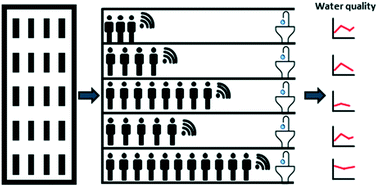Tracking copper, chlorine, and occupancy in a new, multi-story, institutional green building†
Abstract
Water quality deterioration in buildings poses risks to human health and infrastructure. As such, this research tracked the concentrations of copper and chlorine in the tap water of a new, multi-story, LEED Platinum building over its first six months of occupancy to gain new insights into the building water quality. The building is typical of a university research building, which contains laboratory, office, and common spaces, and is representative of commercial and institutional (CI) buildings in general. Twice weekly, first and second draw grab samples of domestic cold water were collected from breakroom faucets on each floor of the five-story building. Grab samples were analyzed for dissolved copper (Cu) and free chlorine. Building occupancy was approximated using Wi-Fi access point connections that provided hourly counts of wireless devices on each floor. The access point counts showed occupancy patterns typical of university buildings, such as higher counts on weekdays than on Saturday and Sunday, and higher counts during the workday compared to other times. Overall building occupancy was low during the first 3 months of the study and then increased during the second 3 months. The total building occupancy over the study duration ranked by floor was 1st > 3rd > 2nd > 4th > 5th, which followed move-in schedules for the building. The 1st, 3rd, 4th, and 5th floors showed statistically significant difference from each other except for the relationship between the 2nd and 4th and the 2nd and 5th floors. Maximum copper concentrations were in the range of 1.2–1.7 mg L−1 and occurred during the first three months of the study. Cu concentrations decreased on all floors over the six months and showed a moderately strong negative correlation with occupancy by floor. Although building occupancy was increasing throughout the study, chlorine was almost never detectable in all samples over the six months.



 Please wait while we load your content...
Please wait while we load your content...